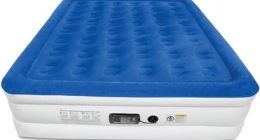
Qualcomm is launching a family of chips that can add incredibly high-speed Wi-Fi — at speeds up to 10 gigabits per second — to phones, laptops, routers, and so on. It’s the start of a new generation of this super-fast Wi-Fi standard, but it isn’t going to be used to speed up your typical web browsing. And whether it catches on at all remains an open question.
Right now, Wi-Fi is on the verge of a major change: over the next year, we’re going to start seeing routers, phones, laptops, and other devices add support for something called Wi-Fi 6, which is supposed to make speeds somewhat, but not incredibly, faster than they are now. Weirdly enough, that’s not what we’re talking about here.
Instead, there’s another Wi-Fi standard being updated, something that’s not meant for the day-to-day use of getting internet at your home or favorite coffee shop. This type of Wi-Fi is meant for very specific purposes, like replacing a virtual reality headset’s data cable with a high-speed wireless link — you can think of it more like a single-purpose wireless cable, than a traditional Wi-Fi connection.
Wi-Fi has already been used for this purpose for the past couple years, using a wireless technology called WiGig. WiGig relies on a connection standard known as 802.11ad, which can hit speeds up to 5 gigabits per second over close to 10 meters, according to Dino Bekis, the head of Qualcomm’s mobile and compute connectivity group.
Qualcomm’s latest chips move WiGig up to a new generation of that wireless standard, called 802.11ay, which Bekis says can reach speeds twice as fast, and can do so up to 100 meter away. The Wi-Fi Alliance says the new standard “increases the peak data rates of WiGig and improves spectrum efficiency and reduces latency.”
So why not just use this as normal Wi-Fi, given how fast it gets? Because that range is only line-of-sight — when there’s literally nothing in the way between the transmitter and the receiver. This high-speed Wi-Fi is based on millimeter wave radio waves in the 60GHz range. That means it’s really fast, but also that it has a very difficult time penetrating obstacles, like a wall. That’s a problem if you want a general purpose wireless technology.
That’s why 802.11ay, like 802.11ad before it, is being used as an optional add-on to existing Wi-Fi technology. If you’re one of the people who has a need for these extreme wireless speeds, then maybe you’ll find a use for it. Just keep in mind, you’ll probably need to keep your router and the device receiving these high speeds in the same room in order for it to work, due to the whole “walls” issue.
It’s not clear if this will really catch on, though. While there’s definitely room for adoption from VR gamers, the earlier version of this tech has found minimal pickup in its couple years on the market. Asus recently made interesting use of it with the ROG Phone, which is designed for gamers. And Qualcomm says it’s working with Facebook to use this tech for its Terragraph project, which wirelessly delivers home internet connections.
WiGig will also, in some ways, be competing with 5G, which makes very similar use of these radio waves to offer similarly fast speeds over similarly limited distances. 5G isn’t meant to be used within a home like this, so WiGig may find a place there. But the two standards may be competing as an option for delivering internet from a tower to a home — that’s what Facebook’s Terragraph is doing with WiGig, and it’s what Verizon is doing with 5G.
For now, you don’t have to worry about any of this. If you’re buying a router next year, you’re still going to just be looking out for that “Wi-Fi 6” logo. If WiGig catches on and ends up in a product you buy, it’ll likely be an advertised feature; you’ll probably have to buy something new to support it, and whatever that is will likely work in addition to Wi-Fi 6, rather than as a replacement for it.
This article is from The Verge






